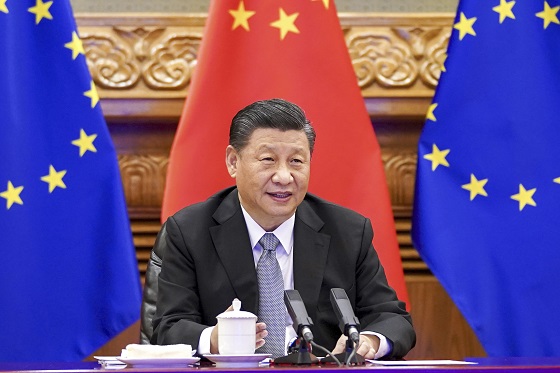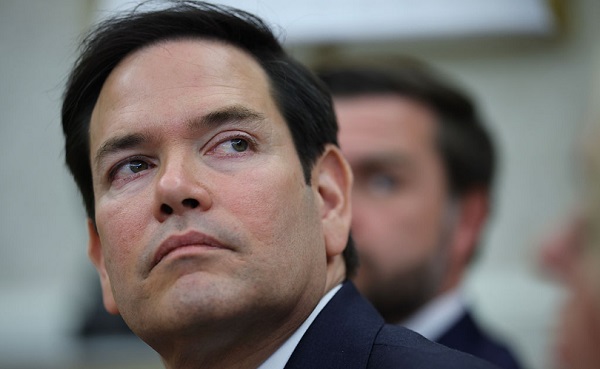Christopher Rufo
Luigi Mangione and Left-Wing Nihilism

The assassination of the UnitedHealthcare CEO represents a dark turn in our politics.
The following transcript of the episode has been lightly edited for clarity:
The most significant story in this week’s news cycle was, without a doubt, the spectacular assassination of the UnitedHealthcare CEO Brian Thompson and the subsequent capture of his alleged assassin: a young, handsome, well-educated person named Luigi Mangione, who authorities say was in possession of a weapon and a manifesto outlining a possible motive for the crime. The assassination itself, which unfolded last week, was engineered for maximum spectacle, and in fact, it was captured on a CCTV camera, and these images rocketed across the country and across the world. This was a spectacular assassination because the target was the CEO of a major corporation. The execution was brazen. The assassin, who wore a mask and a hood, patiently approached the CEO as he was exiting a hotel on the streets of Manhattan—and then, at close range, with cold calculation, pulled the trigger multiple times until he was dead. On the scene, police found shells of the bullets etched with phrases like “deny, defend, depose,” indicating a deliberate preparation—this was a cold-blooded killing—as well as an ideological motivation. There was resentment, anger, and hatred because of UnitedHealthcare and, supposedly, because of its policies.
This week, there was another layer added to this story that made it even more of a media-feeding frenzy. The suspect and alleged assassin was revealed as a young man named Luigi Mangione, who had all the outward trappings of success. This was an individual who comes from a very wealthy family in the Baltimore area. He’s handsome by appearance, physically fit, he appears to be highly intelligent from the trail of social media posts that he left, and he had two degrees, which he earned in quick succession from the University of Pennsylvania—part of the Ivy League. You had these two seemingly incongruous images or stories suddenly collapsing into one another, and it led to this great question: Why? Why would someone who in theory has everything in life—looking ahead in his life everything is looking up—and yet he succumbed to this very dark assassination? He orchestrated it carefully, he attempted to escape, and then he was caught in a very marginal position, huddled in a McDonald’s in the middle of nowhere, Pennsylvania.
It’s important to take this seriously at two levels. The first level, of course, is trying to trace the ideological progression of Luigi Mangione from the details that we’ve discovered in the media to try to understand both his stated rationale, but then also, perhaps, the underlying psychological motivation behind this crime. Secondarily, it’s important to see this crime, which has set off a media feeding frenzy—you have look-alike contests, you have people idealizing and even idolizing this individual, you have even popular politicians such as Alexandria Ocasio-Cortez, Bernie Sanders, and Elizabeth Warren trying to harvest some of this energy that has been unleashed by this revenge killing into their political program, their left-wing economic program—while, of course, carefully creating some deniability, some distance, between themselves and the actual crime of murder.
First, let’s look at the question of motive. Motive is a key element in any criminal investigation, but in a political crime, which this by all accounts appears to be, it’s even more important. Mangione was like many of us who have an elite education, who grew up at least part of our lives on the Internet—we leave a trail of posts, of engagement, of comments, of interactions as part of our digital life, and he was no exception. He left a trail of clues, a trail of statements, a trail of bits of information on the social media platform X, on the publication platform Substack, and on the reader-sharing application Goodreads. Is this a total revelation of all of his thoughts, feelings, motivations, and problems? No. But it does give us some information to start piecing together.
What strikes me is that his ideological development—you can look at it over the last years by tracing his readings, his statements, his interests—and a few years ago—and the left-wing press has really focused on this as the source of his ideological transgressions or resentments—it started with what I could think of as elite centrist ideologies. He was sharing content from Yuval Noah Harari, who is the World Economic Forum guru who thinks that human beings are rats that have to be guided through the maze of the modern world, and that we can someday overcome our own nature. He was sharing content from the social psychologist Jonathan Haidt, who has captured in a substantive way some of the professional class anxieties about technology, youth behavior, and with other colleagues around natalism and birth rates, which were also a focus of Mangione’s a couple of years ago. Then third, you have him sharing content and discussing content from the Stanford scientist and health guru Andrew Huberman. I think of him as the cold tank protocol—all of these small lifestyle adjustments and healthcare protocols and supplement routines that, in theory, take the human being to another level of performance. Again, reducing human nature to its biological nature—you can make incremental improvements, you could take these supplements, you could sit in an ice bath for an hour, and you’ll be 12% more effective. These are banal elite ideologies. That’s not to say that there’s no truth to all of them. There are certainly some insights that are worth garnering. But what all these have in common is a popularity and a safety in elite circles. You can follow Harari, you can follow Haidt, you can follow Huberman—you’re signaling, perhaps, some dissidence from the establishment, the left-liberal establishment—but you’re well within the confines of elite ideologies that are reducible, and this is important, to a scientific and quantifiable base. This is almost a McKinsey-style ideology, which ties in very much to the world of elite Ivy Leagues.
But beginning perhaps two years ago, certainly a year ago, and accelerating in recent months, you saw a change in his consumption, a change in his discussion. He moved from banal elite ideologies to what I think of as banal radical ideologies. He wrote a review of the Unabomber’s manifesto that was quite positive. I think he gave it four stars on Goodreads, and he felt sympathy with some of the more radical ideas—some of the rationalizations for violence that were in Ted Kaczynski’s manifesto. He also bought into a left-wing corporate greed narrative. This is a standard narrative over the past 100 years in American life that is mobilized on the left, especially in times of economic uncertainty, that has the populist component. It explains misery, misfortune, and ill health because of corporate greed, corporate corruption, and corporate malfeasance. It provides a great target upon which to project one’s own miseries.
He was also talking about new age, radical ideologies in the form of psychedelics. If you’ve been around tech centrists in Silicon Valley, New York, or Seattle, there’s a subculture that has adopted psychedelics, not a countercultural phenomenon like it might have been in the late 1960s, but as a way to unlock creativity, insight, productivity—the Steve Jobs typification of psychedelics that are not only deemed acceptable in these professional environments but deemed a substitute for a grounded religious life. You can go to a shaman in South America, slurp a cup of Ayahuasca, and unlock your brain, which can then be used to demystify the world. You can find your authentic self, and then you can exit the trappings or the drudgeries of the modern capitalist society.
You’re watching this arc of transformation, and simultaneously, some of the personal tidbits start to stack up. This is an individual who went through what appears to be a very painful back surgery. There were published reports saying that he may have lost his job at a tech firm where he was working as an engineer. And then he was living, at least for a time, in a commune environment in Hawaii—the kind of new age, professional class, affluent communities. These are features of some places around the world. You have them in some boroughs of New York, you have them in places like Berkeley, California, and places like some of the more secluded places in Hawaii. There is the potential, although it’s not totally confirmed, that this narrative of personal struggle, personal pain, personal unhappiness because of his medical condition—in the context of someone who was very healthy, very strong, very physically fit, he was an athlete, at least high school—could have led him to snap. We have the personal progression layered onto the ideological progression, but whatever combination of these happened, what’s certain is that he did snap—because someone who is well can see the folly in murdering someone on the streets in cold blood. Someone who is unwell can rationalize that action, which is exactly what he did.
But we have another, more important layer that we can peel back in two places. When the police caught him in Altoona, Pennsylvania, he had an alleged manifesto—a few hundred words—and a spiral-bound notebook with specific notes that are alleged to be part of the planning of this crime. This is where it becomes very interesting, because the more specific that we get about the actual crime, the more it dovetails and mimics the narrative structure of radical left-wing ideologies, and, as I’ll argue, radical left-wing nihilism.
At the beginning of the supposedly handwritten manifesto, he says some boilerplate leftist lines—that we have the most expensive healthcare in the world and yet the 42nd longest life expectancy. In other words, we’re not getting the value that we’re putting into it. And the critical question is then: Why? And he has an answer. He denounces “the corruption and greed in the industry. He denounces their quest for “profit” and in the other notebook, he said he wanted to murder the CEO of the largest health insurance company at the annual, parasitic, bean-counter convention. We can break down each of those words. “Parasitic” is a left-wing trope: capitalist parasites extracting the labor of the working class—or in this case, insurance company parasites extracting from the pain of struggling Americans. Then he calls it a bean-counter convention. The CEO was trained as an accountant. The insult here is that you can’t put a price on health, on human beings, on goodness—but that’s exactly what these capitalist parasites do, and therefore, they deserve to be eliminated because they don’t have an appreciation for life. They merely monetize it and convert it into death.
What’s interesting about this manifesto is two things. One is that for a very smart person, he’s reduced it to very simplistic, left-wing narratives, and it was only a few hundred words. He didn’t even actually think through why he was committing the crime in detail. In fact, he says at one point, “I do not pretend to be the most qualified person to lay out the full argument about the corruption of America’s healthcare system”—and yet he felt he was educated enough to plot and execute a plan to murder this company’s CEO.
Beneath this admittedly surface-level, left-wing rhetoric, what is really happening here? It’s something that I have witnessed over the last few years and documented in various capacities, but it really comes into sharp focus here. It’s a form of left-wing nihilism.
Typically, the left likes to present itself as left-wing progressivism. “We’re going to make the world better. We’re going to provide more healthcare. We’re going to get a public option. We’re going to have the Affordable Care Act. We’re going to have a single-payer system that will provide care and value each human being.” That’s the narrative in a traditional left-wing progressivism. But once that wears off—certainly the failure of Obamacare contributes to this, certainly the failures of the Sanders-Warren wing of the party have contributed to this—as those narratives have been sloughed off and abandoned as impractical (more accurately, as counterproductive), you see a new form of left-wing nihilism, which is the other side of the coin of left-wing progressivism. “If we can’t build a healthcare system, let’s destroy the existing healthcare system”—and perhaps out of this catastrophic destruction, something better will emerge.
The reason for this is quite simple if you look at it from the outside honestly. Building a society and building a national healthcare system for 340 million people is hard. Assassinating an unsuspecting individual on the streets of Manhattan is relatively easy. So the energy gets directed into that direction because the energy seeks opportunity, and then whatever psychopathology that is living inside these individuals—and certainly, Luigi Mangione had some psychopathology living inside of him—can then use those narratives as an intellectual rationalization. He’s a smart person. He was seeking some rationale for what is likely a complex mix of ideological and personal reasons why he wanted to commit this crime.
What’s the big problem with this is obviously the murder. You should not murder people for no reason on the streets of Manhattan. This is obvious, although not as obvious as it should be. Some people are really struggling with that. But the second problem, and the deeper problem, is that it reveals the extent to which madness and nihilism have been baked into our culture. Someone who is an Ivy League graduate, someone who has a strong family network, someone who has wealth and health and opportunity ahead of him decides to go down this dark path. That’s why there’s a fascination about this case. If it was an unknown, anonymous vagrant who stabbed someone in the street, it’s a blip. But we’ve raised the stakes, because what this shows—and for those of us in the media who share the same kind of educational background as this individual, as both of these individuals—it creates this window that America’s elite is simultaneously failing to restrain the psychopathologies of too many young people, and that the elite ideologies—both the elite ideologies that are more conventional and the elite ideologies that are even more radical—offer no path of constructive action. In fact, they are preying on people who, for their own reasons, are feeling a sense of rage, a sense of destructiveness, a sense of passion. It gives them the keys and the language to act on that in highly symbolic ways, but nonetheless extremely destructive ways.
There’s a cynical element to this as well because those political actors on the left, while saying, “Oh, I condemn violence. Violence is bad. Murder is not okay”—that perfunctory caveat—they’re saying, “Well, maybe he had a point. Maybe the insurance executive had it coming. Maybe our healthcare system is broken.” What they’re doing is they’re harvesting psychopathology. They’re harvesting seemingly random acts of violence, and they’re using them as ammunition for their own political campaigns. They’re using the spectacle, this bloodthirsty spectacle, committed by a handsome, well-educated, intelligent young man, in order to advance progressivism on the back of nihilism.
Secondly, beyond the individual dynamics, what does this case represent as a whole? It represents a unique historical transition in our time from historical idealistic leftism to a historical nihilistic leftism. What I mean by that is really important. We’ve seen, especially this past few months, what I think of as the exhaustion of the BLM mass movement. BLM as a particular mass movement is finished. We saw that with the Daniel Penny verdict in New York this week. But what happens after the splintering, the self-devouring, and the self-destruction of left-wing mass movements is that they splinter into a multiplicity of fringe movements, and fringe movements even at the level of one individual…
Watch with a 7-day free trial
Subscribe to Christopher F. Rufo to watch this video and get 7 days of free access to the full post archives.
A subscription gets you:
| Weekly podcast | |
| Subscribers-only Q&A | |
| Behind-the-scenes access |
Automotive
Trump Must Act to Halt the Tesla Terror Campaign

 Christopher F. Rufo
Christopher F. Rufo
The Left’s splintering violence threatens a veto over democratic power.
Elon Musk finds himself at the fulcrum of American life. His companies are leading the field across the automotive, space, robotics, and AI industries. His ownership of the social platform X gives him significant influence over political discourse. And his DOGE initiative represents the single greatest threat to the permanent administrative state. Musk is arguably the most powerful man in the United States, including President Trump.
The Left has taken notice. Left-wing activists have long practiced a tactic called “power mapping,” which entails diagramming the opposing political movement and identifying “chokepoints.” They have designated Musk as one such chokepoint. This month, activists claimed to have organized 500 protests against Elon Musk’s Tesla—dubbed the “Tesla Takedown”—with demonstrations outside sales lots and a series of incidents of vandalism, property destruction, and fire bombings. A pattern has also emerged of individuals scratching or spray-painting parked Teslas, looking to intimidate owners and potential owners or just to express hatred of Musk.
Precedents exist for this kind of escalation. In the 1970s, following the frustrations of the civil rights era, left-wing splinter groups launched targeted terror campaigns and symbolic acts of violence. They bombed the U.S. Capitol, assassinated police officers, and even self-immolated in imitation of Buddhist monks. We may be entering a similar phase today, as the collapse of the Black Lives Matter movement gives rise to radicalized left-wing factions willing to embrace violence. If so, Musk’s Tesla may be the Number One target.
What, exactly, motivates this campaign? At its core, the Left appears to be shifting from an “antiracist” narrative to an anti-wealth one—from a racial frame to an economic one. The sentiment driving the Tesla Takedown is rooted in economic resentment and a desire for leveling. Musk has become a symbol of everything progressives oppose: oligarchy, capitalism, wealth, and innovation. These, in their view, are marks of the oppressor. They scorn the futuristic Cybertruck, SpaceX rockets, and Optimus robots, believing that such creations should be dismantled and repurposed into chassis for public buses or I-beams for public housing.
A certain element of left-wing Luddism is at work here, but the greater part of these activists’ motives is resentment. Musk represents the triumph of the great man of industry, something the Left believes should not exist.
Unfortunately, the Tesla Takedown may succeed. The Left has likely identified Tesla as a chokepoint because it’s easier to dissuade consumers from buying a car they associate with a malevolent political cause—or fear might be vandalized—than it is to persuade them to buy one in support of Musk and DOGE. When it comes to purchasing a Tesla, fear among the average American is a more powerful motivator than enthusiasm among the MAGA base.
Some evidence suggests that the campaign has made an economic impact. Tesla stock peaked around the time of President Trump’s inauguration and since then has lost approximately 40 percent of its value. Musk has accumulated more power than any other American, but that means that he has more points of vulnerability. His wealth and power are tied to his companies—most importantly, his consumer car company, which depends on individual purchases rather than institutional contracts (like SpaceX).
Trump has signaled that he understands this dilemma. He appeared at the White House in a Tesla and has voiced support for Musk’s firms. Justice Department prosecutors—and their allies in state government—must translate this support into policy by identifying and punishing those who destroy property as a means of political intimidation.
The administration needs to make clear that radical left-wing factions cannot use violence to wield a veto over democratic governance. If the partnership between Trump and Musk is to produce meaningful results, it must be backed by the full protection of the law.
Business
The NSA’s Secret Sex Chats

|
|
Intelligence officials maintained a chatroom to discuss polyamory and transgender surgeries, internal documents reveal.
The “intelligence community” is one of the most powerful parts of the American national security apparatus. In theory, it works tirelessly to keep the nation safe. But according to internal documents that we obtained, some intelligence agency employees have another on-the-job priority: sex chats.
We have cultivated sources within the National Security Agency—one current employee and one former employee—who have provided chat logs from the NSA’s Intelink messaging program. According to an NSA press official, “All NSA employees sign agreements stating that publishing non-mission related material on Intelink is a usage violation and will result in disciplinary action.” Nonetheless, these logs, dating back two years, are lurid, featuring wide-ranging discussions of sex, kink, polyamory, and castration.
One popular chat topic was male-to-female transgender surgery, which involves surgically removing the penis and turning it into an artificial vagina. “[M]ine is everything,” said one male who claimed to have had gender reconstruction surgery. “[I]’ve found that i like being penetrated (never liked it before GRS), but all the rest is just as important as well.” Another intelligence official boasted that genital surgery allowed him “to wear leggings or bikinis without having to wear a gaff under it.”
These employees discussed hair removal, estrogen injections, and the experience of sexual pleasure post-castration. “[G]etting my butthole zapped by a laser was . . . shocking,” said one transgender-identifying intel employee who spent thousands on hair removal. “Look, I just enjoy helping other people experience boobs,” said another about estrogen treatments. “[O]ne of the weirdest things that gives me euphoria is when i pee, i don’t have to push anything down to make sure it aims right,” a Defense Intelligence Agency employee added.
These revelations come at a moment of heightened scrutiny for the intelligence community. President Donald Trump, Defense Secretary Pete Hegseth, and Director of National Intelligence Tulsi Gabbard have each made the case that the intelligence agencies have gone “woke,” prioritizing left-wing activism over national security. These chat logs confirm their suspicions and raise fundamental questions about competence and professionalism.
According to our sources, the sex chats were legitimized as part of the NSA’s commitment to “diversity, equity and inclusion.” Activists within the agency used LGBTQ+ “employee resource groups” to turn their kinks and pathologies into official work duties. According to the current NSA employee, these groups “spent all day” recruiting activists and holding meetings with titles such as “Privilege,” “Ally Awareness,” “Pride,” and “Transgender Community Inclusion.” And they did so with the full support of NSA leadership, which declared that DEI was “not only mission critical, but mission imperative.”
In this case, “diversity” was not a byword for racialism, but rather a euphemism for sex talk. Last January, chatroom members discussed their practice of polyamory, or “ethical non-monogamy.” “[A] polycule is a polyamorous group,” one employee explained. “A is my [girlfriend], and B-G are her partners. . . . then B&C are dating but not C&D, nor E, F, or G with any of the others, though there are several MWB (metas-with-benefits) connections.” Another employee claimed to be part of a nine-member “polycule,” adding that “some of our friends are practically poly-mers, with all the connected compounds.”
At other times, the conversations became explicit. The active source at the NSA claimed to have witnessed hundreds of sexually provocative discussions, which, he added, occurred mostly on taxpayer time. The former NSA source who was familiar with the chats recalled being “disgusted” by a particularly shocking thread discussing weekend “gangbangs.”
The NSA sources also raised the question of some staffers’ mental fitness for the job. In one chat, an NSA employee insists on using “it” pronouns in lieu of the human “he” or “she” pronouns. “[I]t/its user here. While I understand we can make some people uncomfortable, keep in mind that the dehumanizing aspect either a) doesn’t apply or b) is a positive effect when we’re requesting it.” A commenter who disagreed was quickly dismissed by employees of the NSA and CIA, who claimed that refusing to use “it/its” pronouns amounted to “erasing” a transgender identity.
“These are folks with top secret clearances believing they are an IT!” said the NSA source.
With the Trump administration taking over, we may see changes. The NSA source said that staffers involved in employee resource groups fear the end of DEI. “[T]here are legal restrictions in place, but this admin has shown they don’t give a f**k about legality,” a staffer in space intelligence remarked about DEI staffers being placed on leave. Others have expressed opposition to Trump’s cabinet nominees.
A conflict is coming. These NSA chat logs suggest the presence of at least hundreds of gender activists within the intelligence services who cannot distinguish between male and female, and who believe that discussing castration, polyamory, and “gangbangs” is an appropriate use of public resources. For psychological and ideological reasons, these kinds of people will not be easily sidelined. The Trump administration should not only dismantle the structure of DEI but also terminate the employees who use it to advance gender activism at the expense of national security.
 |
A guest post by
|
Subscribe to Christopher F. Rufo.
For the full experience, upgrade your subscription.
-

 2025 Federal Election2 days ago
2025 Federal Election2 days agoPolice Associations Endorse Conservatives. Poilievre Will Shut Down Tent Cities
-

 2025 Federal Election17 hours ago
2025 Federal Election17 hours agoStudy links B.C.’s drug policies to more overdoses, but researchers urge caution
-

 Alberta2 days ago
Alberta2 days agoRed Deer Justice Centre Grand Opening: Building access to justice for Albertans
-

 Business2 days ago
Business2 days agoTrump: China’s tariffs to “come down substantially” after negotiations with Xi
-

 conflict2 days ago
conflict2 days agoMarco Rubio says US could soon ‘move on’ from Ukraine conflict: ‘This is not our war’
-

 Business1 day ago
Business1 day agoChinese firm unveils palm-based biometric ID payments, sparking fresh privacy concerns
-

 2025 Federal Election1 day ago
2025 Federal Election1 day agoFormer WEF insider accuses Mark Carney of using fear tactics to usher globalism into Canada
-

 2025 Federal Election2 days ago
2025 Federal Election2 days agoCanada’s press tries to turn the gender debate into a non-issue, pretend it’s not happening








